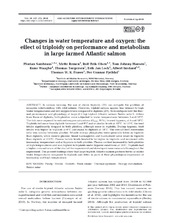| dc.contributor.author | Sambraus, Florian | |
| dc.contributor.author | Remen, Mette | |
| dc.contributor.author | Olsen, Rolf Erik | |
| dc.contributor.author | Hansen, Tom Johnny | |
| dc.contributor.author | Waagbø, Rune | |
| dc.contributor.author | Torgersen, Thomas | |
| dc.contributor.author | Lock, Erik-Jan | |
| dc.contributor.author | Imsland, Albert | |
| dc.contributor.author | Fraser, Thomas W.K. | |
| dc.contributor.author | Fjelldal, Per Gunnar | |
| dc.date.accessioned | 2019-04-04T12:35:11Z | |
| dc.date.available | 2019-04-04T12:35:11Z | |
| dc.date.issued | 2018 | |
| dc.Published | Sambraus F, Remen M, Olsen RE, Hansen TJ, Waagbø R, Torgersen T, Lock E, Imsland A, Fraser, Fjelldal PG. Changes in water temperature and oxygen: the effect of triploidy on performance and metabolism in large farmed Atlantic salmon. Aquaculture Environment Interactions. 2018;10:157-172 | eng |
| dc.identifier.issn | 1869-215X | en_US |
| dc.identifier.issn | 1869-7534 | en_US |
| dc.identifier.uri | https://hdl.handle.net/1956/19276 | |
| dc.description.abstract | In salmon farming, the use of sterile triploids (3N) can mitigate the problem of escapees interbreeding with wild salmon. However, triploid salmon appear less tolerant to high water temperatures and low oxygen levels compared to diploids (2N). To investigate how the thermal performance and physiology of large (2.5 kg) triploid Atlantic salmon Salmo salar L. differs from those of diploids, both ploidies were subjected to water temperatures between 3 and 18°C. The fish were exposed to reduced oxygen saturations (O2 sat, 70%), termed hypoxia, at 6 and 18°C. Triploids fed more than diploids between 3 and 9°C and at similar levels at 12°C. At 15°C, the feed intake significantly dropped in both ploidies, although more in triploids. During hypoxia, feed intake was higher in triploids at 6°C and equal to diploids at 18°C. The overall feed conversion ratio was similar between ploidies. Muscle energy phosphates were generally lower in triploids than diploids, while muscle glucose, blood haemoglobin and haematocrit were lower in triploids than diploids at ≥12°C. Plasma lactate levels tended to be higher in triploids and increased with increasing temperature and at hypoxia in both ploidies. Plasma cortisol increased in both ploidies at high temperatures and was highest in triploids under hypoxic conditions at 18°C. Triploids had a higher cataract score at the start of the experiment and developed more cataracts throughout the experiment. The present findings show that large triploid Atlantic salmon perform better at colder water temperatures compared to diploids and differ in parts of their physiological expression at increasing and high temperature. | en_US |
| dc.language.iso | eng | eng |
| dc.publisher | Inter-Research | en_US |
| dc.rights | Attribution CC BY | eng |
| dc.rights.uri | http://creativecommons.org/licenses/by/4.0/ | eng |
| dc.subject | Ploidy | eng |
| dc.subject | Sterile | eng |
| dc.subject | Growth | eng |
| dc.subject | Feed intake | eng |
| dc.subject | Thermal optimum | eng |
| dc.subject | Energy metabolism | eng |
| dc.subject | Salmo Salar | eng |
| dc.title | Changes in water temperature and oxygen: the effect of triploidy on performance and metabolism in large farmed Atlantic salmon | en_US |
| dc.type | Peer reviewed | |
| dc.type | Journal article | |
| dc.date.updated | 2018-07-13T07:14:02Z | |
| dc.description.version | publishedVersion | en_US |
| dc.rights.holder | Copyright 2018 the author(s) | en_US |
| dc.identifier.doi | https://doi.org/10.3354/aei00260 | |
| dc.identifier.cristin | 1581148 | |
| dc.source.journal | Aquaculture Environment Interactions | |
| dc.relation.project | Norges forskningsråd: 216197 | |
| dc.relation.project | Fiskeri- og havbruksnæringens forskningsfond: 900723 | |

